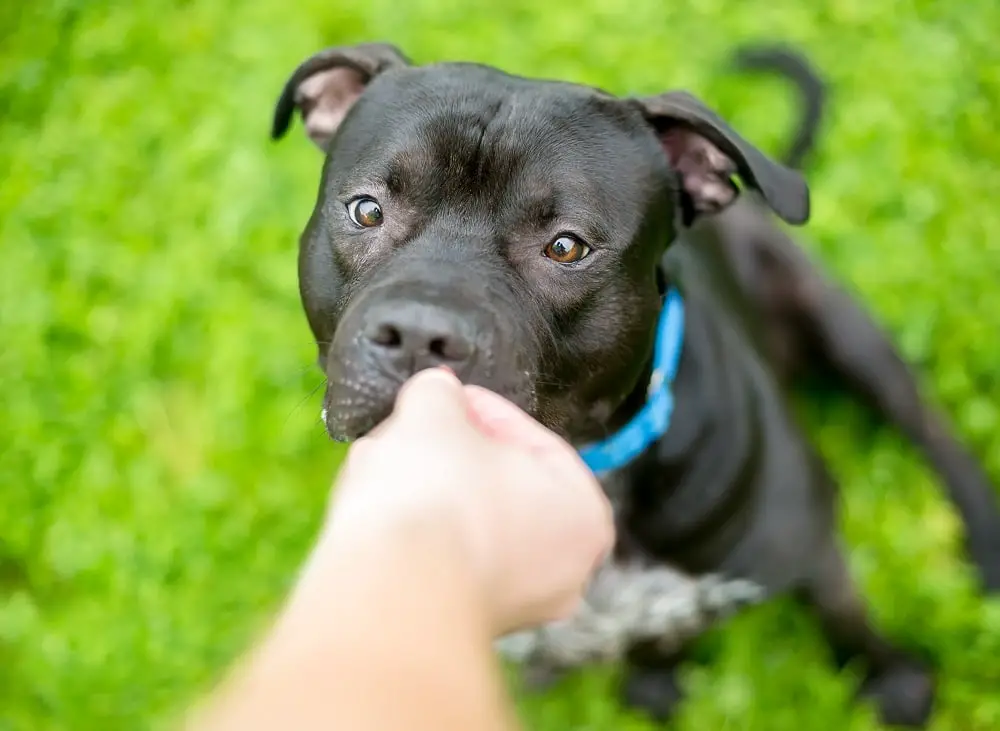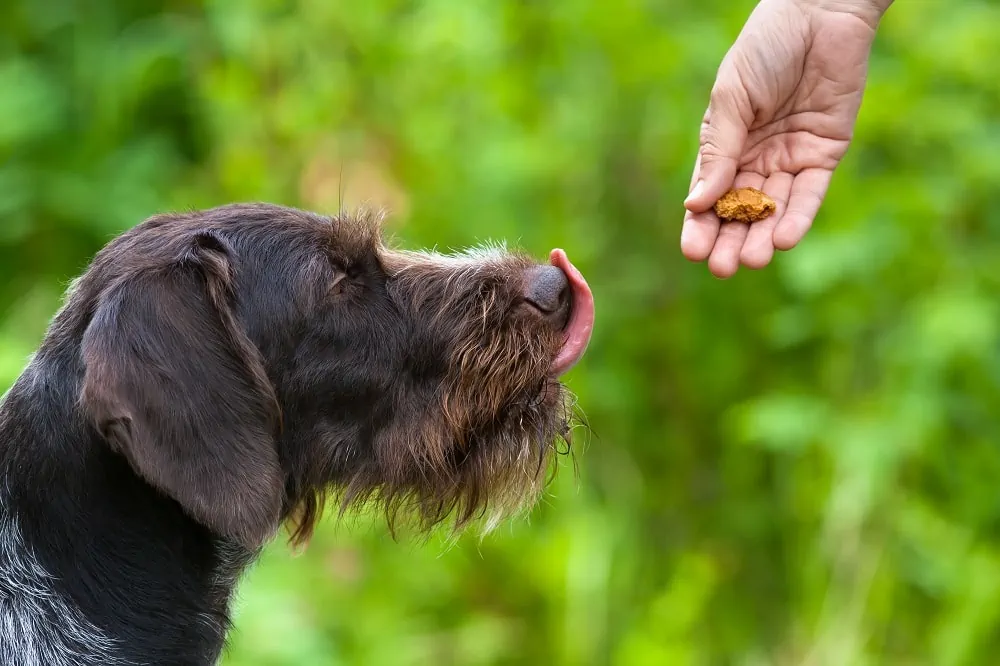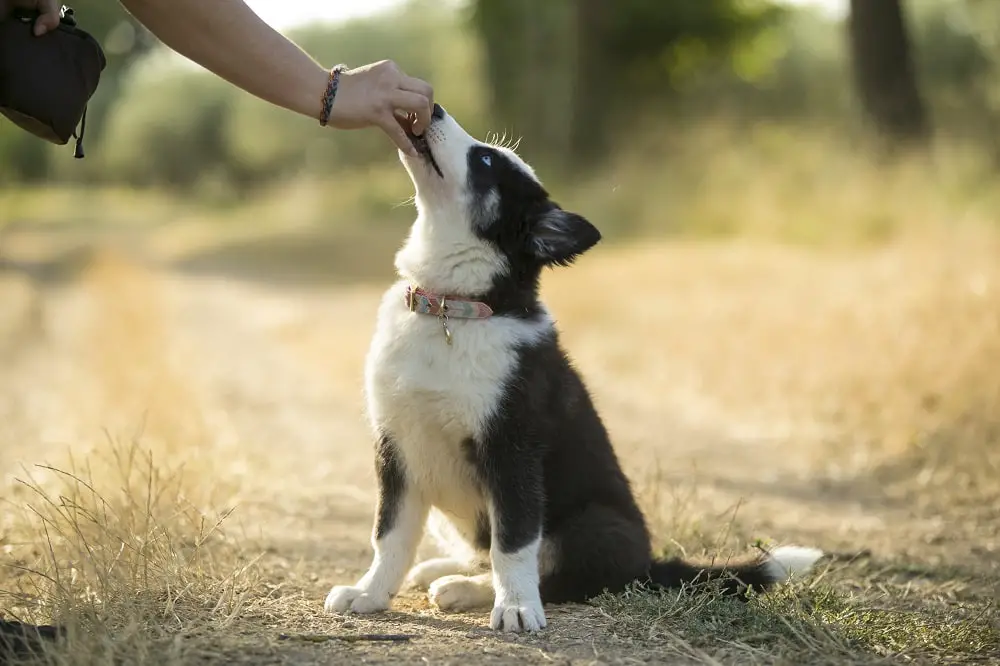We live in an ever-evolving society and, with the dramatic increase in the popularity of “fur babies,” people are now looking for the best ways in which to look after their precious pets.
So what should you do first before giving a dog a treat? Before giving your dog a treat you need to consider the right age at which to start giving treats, the correct method so as not to encourage bad habits, and which treatment options are the healthiest. Then, you can begin the training process to incentivize good behavior using a treat-based reward system that communicates to the dog what is expected of them.
Pets owners are faced with a myriad of questions. We ask ourselves how best to groom our pet, which dog toys to buy, and what insurance will give our pets the best coverage. Of course, we also face the question of which food to give our pets, when, and why.
Why Treat a Dog?
Treats are a useful way to reward and reinforce good behavior.
Although many of us are inclined to just feed our animals scraps from our own tables and call it a “treat.” A so-called “science” behind giving a dog a treat actually exists.
Unlike the regular meals we feed our dogs, treat giving can have a very functional purpose. It’s a way in which we can communicate with our dogs, a way of bridging the language barrier and creating an understanding between owner and pet.
Dogs are very much like humans in so many ways, but one of the most fundamental ways in which we are alike in that we are greatly motivated by food.
Unlike humans, dogs are not able to just jump into the car and pop around to the corner shop when they have a craving for something salty. No, they rely on us, and it is because of this that we need to understand why to treat a dog.
Because dogs adore food, it can be a very powerful tool in training them to be functional members of society. However, it can also be a pitfall, so it’s important to distinguish when it is one or the other.
As dogs become such a bigger, more noticeable, presence in human society, it is becoming increasingly imperative that they learn to behave themselves in an appropriate way.
And while you may be thinking, “But it’s just a dog,” people’s expectations of them have grown. Dogs who are now brought into coffee shops and supermarkets and the like are expected to be able to behave themselves.
Dogs who insist on barking and marking their territory all over the cafe floor might not be welcomed back a second time.
So, as pet owners, we can use treats, not only as a way to reward good behavior but also as a means to reinforce skills that we want them to learn and later exhibit.
When to Give your Dog Treats

Dog owners often wonder when to start giving your dog treats. While it is important to wait for them to be ready physically, it is also important for them to be mentally and emotionally ready.
Of course, there is no point in trying to give your dog treats before they’ve started eating solid food. The American Kennel Club (AKC) recommends that you only start giving your puppies solid food from about six weeks of age.
The AKC also provides a great first year feeding timeline for pet owners on their website.
Once your dog has started on solid food, you can monitor how they eat and go from there. But don’t be in such a hurry to give your puppies treats. Babies aren’t given anything but milk for the first six months of their lives because they don’t need anything else.
Puppies don’t need treats. As it is such a critical time in their growth and development, it’s important to feed them right and feed them well.
Once they start puppy training, which usually takes place when they’re about six months old, then it’s advisable to give them treats. This sets a good precedent for introducing treats on a reward basis rather than just as an everyday occurrence.
If you decide to skip the formal training and train your dog at home, then there is an interesting article on WebMD’s Pet platform which discusses the best feeding and nutrition plan for puppies.
There is quite a bit of information available on how many treats your dog should be allowed. Nutrition experts at the American Society for the Prevention of Cruelty to Animals recommend that treats be in the region of about 5% of the dog’s total food intake (source).
The American Kennel Club recommends that owners keep a careful watch on the calorie content of dog treats, and you can do so easily by checking the back of the packaging. The AKC suggests that treats should not total more than 10% percent of the dog’s diet (source).
Elizabeth Lee of WebMD also advises that pet owners should, “choose treats that are the right size for your puppy.” This is a really important point, especially for dog owners who have a range of different sized dogs. There is no one-size-fits-all rule in this case.
For example, you should never give a Jack Russell the same size treat as a Great Dane; it’s like giving a child an adult portion at a restaurant–it’s excessive and unnecessary.
Would You Like the Fish or the Chicken?
Not all treats are made equal. Don’t do harm by trying to do good.
We are all guilty of feeding our pets from our tables. Sometimes we can’t help it. We look down and see those big brown eyes staring at us from under the table. We quietly sneak something to the poor, starving pooch. We are only human after all.
Not only does feeding a dog from the table set a bad precedent, but it can also be very unhealthy for your dog.
Dr. Ken Tudor wrote an interesting article on why we should treat our pets. His argument is that we should not be giving them treats at all. One reason he states is that “Americans alone spend approximately $3-4 billion dollars [sic] per year on pet treats” (source).
He goes on to say that a huge percentage of pets are above their recommended weight and that this overeating is largely caused by an uncontrolled intake of treats.
While he makes a few valid points, it is unrealistic to think that pet owners will stop giving treats to their dogs. We should instead be shifting our ways of thinking and start considering bringing in all factors into the equation.
Before choosing a treat for our dogs, we should always consider things like calorie count, exercise regime, and age. They are all important to consider before choosing what treats to give your dogs.
It’s very important to remember that human food can have serious and irreversible effects on the health of a dog. It’s also important to know what foods do not make appropriate treats for dogs.
When buying treats, always look for things that are as natural and organic as possible. Or, if you aren’t sure, you can speak to your veterinarian or even make your own dog treats. I know that Pinterest has a million and one ideas for homemade dog biscuits.
You’d be surprised to find out some of the things that dogs like to eat, including fruits and vegetables. If you aren’t sure which foods to avoid giving your dog, the ASPCA provides a pretty comprehensive list on their website of what foods not to give your pets. These include things like chocolate, nuts, grapes, and raisins.
One last point is the question of whether pet owners may give their dog bones. As children, we might grow up believing that is all dogs eat. Even though many owners assume it’s okay to give dog bones, there are others that raise legitimate concerns.
Vets agree that dogs can have bones, but it’s important to follow a clear set of guidelines first like those set out by the AKC. This includes not giving your dog cooked bones and not allowing them to chew the bone into choke-able or blockage-sized pieces.
Vets recommend that you make sure the dog is supervised when eating a bone. They also recommend that you take it away after a while so they aren’t at risk of choking from small fragments of bone.
In short, you can give your dog bones, but make sure that you keep an eye on them. It’s also best that you don’t use bones as a distraction if you are gone all day.
Okay, I Have the Treats! Now What?

How to give your dog treats because, yes, there’s an actual method.
Just as you should take time to consider which treats you buy for your dog and why you should also take the time to consider how you are going to give that treat to your dog.
While it might seem obvious to some, the ways in which you give a dog their treat can influence their behavior. Basically, you need to present the treat to the dog in a way that says, “Hey, I’m here, but you can’t have me yet.”
Whether you are training the dog or just rewarding him for being a good boy, the AKC says that you should hold the treat securely in your hand. You may expose it just a bit so that the dog is aware that it’s there, but not so much that they can’t take it from you. Hold it out to your dog in line with their nose. Make sure you aren’t too far away.
Give the dog instruction and then offer him the treat. Let him have a taste before opening your hand and letting him take the treat gently from the flat of your hand. A good way to put this into practice would be while teaching your dog how to come when called.
For example, our four-year-old labrador gets a treat every evening after dinner, provided she did not beg during the meal. We have clear instructions for her: “Emma, sit. Emma, high-five.” Once we’re satisfied, and as long as she doesn’t jump or snatch, then she gets the treat.
Once you have a method that suits you and your dog, be sure to give your dog a treat in the same controlled and consistent fashion every time. This way the dog will come to learn what to expect and will be able to act accordingly.
The AKC recommends that you don’t throw a treat for a dog or simply give it to them without performing the required ritual. If your dog is a jumper, we have an article that teaches you how you can train your dog not to jump.
It is important to remember that dogs can easily become excitable, leading to snatching, jumping, and uncontrolled behavior. If you are letting children give treats, show them the right way to give the dog their reward.
Always try to remain patient and calm with your pet and be encouraging. There’s a learning curve for you both.
Good Guys Get Rewards
Knowing when to give a treat and when not to is important
Good guys get rewards. It’s as simple as that. Dogs are able to understand the link between doing something right and being rewarded for it. It’s also preferable to encourage good behavior rather than have to punish bad behavior.
Should you find that you do need to correct bad behavior, the AKC recommends communication techniques, training, exercise and of course, patience.
It’s okay to spoil your pet from time to time. Many people give their pets a special treat on birthdays or Christmas. It is a way to communicate our love for them. But it becomes a problem when we use them incorrectly.
Knowing when to give your dog a treat can be quite tricky. We tend to think of pets as people, but it’s important to remember that our pets rely on us to keep them healthy.
Overeating in dogs can lead to serious conditions like canine diabetes and pancreatitis. There is no point in thinking your dog has the willpower to say enough’s enough because, while we’re sure your dog is clever, they’re not that clever.
As a dog owner, one must also avoid rewarding begging. This sets a bad precedent and makes dogs think that it’s acceptable behavior. That’s why it is important to know the correct situation in which to give your dog a treat.
Acceptable reasons to give your dog a treat include the following: to influence behavior while training, on a special occasion, and as a reward. No one is saying you have to be a mean old grouch about it, but just remember that everything is better in moderation.
Learn more on how to give dog treats in this short video:
The Psychology Behind Giving Your Dog Treats
The reality is that most of us have to work. Unfortunately, this means that sometimes our dogs are left at home alone.
Pet owners may feel like they need to overdo the treat because they feel guilty or for a number of other reasons, including trying to make up for the animal’s previous living situation or over-compensating for multi-pet households (source).
While treats are a great way to bond with your dog, using treats as a way to ease our own conscience or try to fix a problem isn’t always the answer. It may be harmful to our pets and result in animals who suffer from obesity and other health problems.
Instead, try to come up with other solutions. If you are away at work a lot, try to organize a pet sitter or a dog-date a couple of times a day.
If you live in a multi-pet household, try to give all the animals a bit of special attention every day. And if your pet has come from a bad home, remember that it will take time for them to settle in but, with love and a good home, they will settle down.
For those looking for a treat-based suggestion, the AKC refers to “Slow-Eating Treats,” which are things that can entertain a dog for an extended period of time.
They recommend that you look for treats that are sustainable, such as bully sticks which the dog can chew on for a while. Another option on the market is toys that can be filled with food.
Final Thoughts
It’s important to think carefully before giving your dog a treat. Consider, for example, how these treats may affect their health or if you might be reinforcing bad habits. It’s important to give it more thought next time you are buying a tasty snack for your pooch.
There is so much to be said on the topic of treats and dogs, but remember that all dogs are different. Like people, some dogs may thank you for your homemade peanut butter dog biscuits, while others might prefer carrots as a treat.
As a pet owner, you have a responsibility towards your furry friend. So take the time to understand them and to find out what really makes them tick.


0 Comments